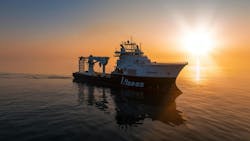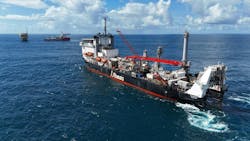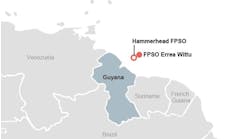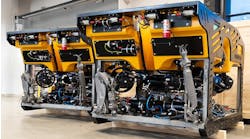Allseas has started preparations for pipelay for the first carbon capture and storage development in the Dutch North Sea.
The Oceanic vessel performed an unexploded ordnance survey along the 20-km pipeline route for the Porthos project (Port of Rotterdam CO2 Transport and Storage).
This was one of various pre-lay activities, and it involved deployment of an imaging and sonar spread.
As main offshore contractor for Porthos, Allseas’ responsibilities cover installation, burial and commissioning of the 16-inch pipeline that will connect a compressor station at the Maasvlakte industrial site in the Port of Rotterdam with the TAQA-owned P18-A platform in the North Sea. The platform is being converted for storing CO2 in a depleted reservoir.
Lorelay is due to start offshore pipelay in late April. The pipeline will have a plastic insulation coating to retain the heat within the pipe and a concrete weight coating to ensure stability on the seabed.
Initially, Lorelay will perform a pull-in to the compressor station before heading toward the P18-A platform, supported by Oceanic. According to Allseas, both vessels have the capability to position precisely and safely in the congested waters around Rotterdam.
The completed pipeline will be used to transport CO2 captured from local onshore industries through the Port of Rotterdam to depleted North Sea gas fields. Porthos is a joint venture between EBN, Gasunie and the Port of Rotterdam.
In the Timor Sea, another Allseas vessel, Sandpiper, has finished nearshore construction work for Santos’ Darwin Pipeline Duplication (DPD) in coastal waters of Australia’s Northern Territory, as part of the Barossa gas-condensate field development.
Sandpiper’s crew had to manage high heat and humidity, strong currents, and tidal changes of up to 8 m to install the DPD’s 32-km shallow-water section, including a pull-in to the onshore Darwin LNG complex.
Other complicating factors were the congested nearshore seabed, containing live gas lines, exclusion areas, protected wrecks and potential unexploded ordnance, with each anchoring position of the vessel having to be pre-engineered accordingly.
To maintain accuracy, the crew deployed the vessel’s fully automatic positioning system, designed in-house by Allseas engineers. The central console acted as the interface for the 10 winches, each spooling 1,500 m of high-strength, self-floating pipelines, to accelerate running of anchors and to improve performance and reliability.






